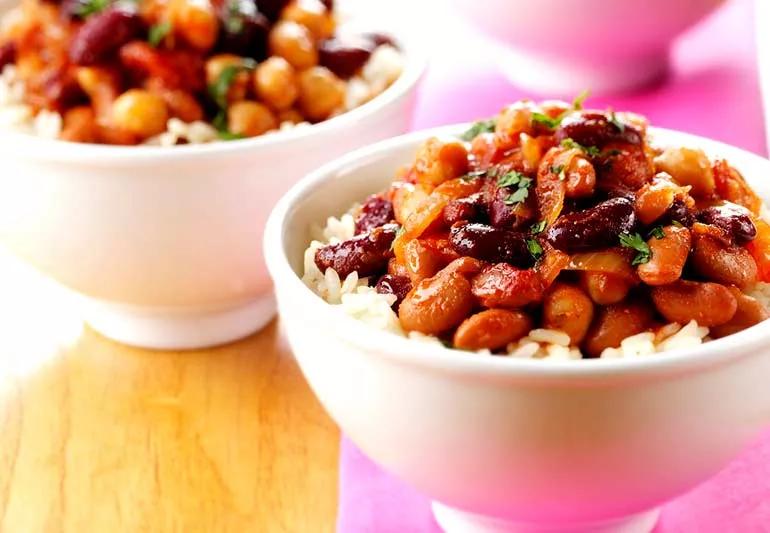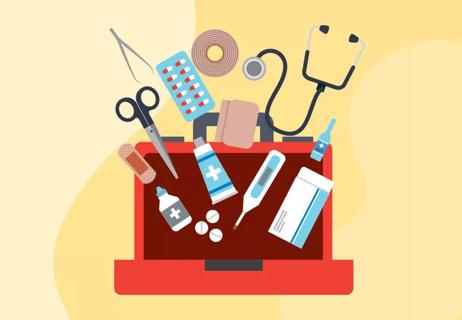Keep healthy foods on hand, like tuna packets, canned veggies and fruits, and beans and rice

Remember those early days of the pandemic? Stuck at home with only enough fresh groceries to last you a week or two, the daily menu looked pretty grim: Lots of PB&Js and mac and cheese, with the occasional veggie here and there before everything became wilted and brown.
Advertisement
Cleveland Clinic is a non-profit academic medical center. Advertising on our site helps support our mission. We do not endorse non-Cleveland Clinic products or services. Policy
Luckily, those days have since become a memory — and they probably taught you a lot about what foods you’re inclined to keep on hand and how you eat amid stressful, homebound times. But do you know about the best foods to stockpile in case of future emergencies?
If you’ve ever watched Chopped, you know that chefs are given a few seemingly mismatched ingredients and tasked with turning them into a tasty, cohesive meal. And while we’re not suggesting that you make an appetizer out of dried lentils and spray cheese (or whatever it is you’ve got hidden in the recesses of your pantry), you can create delicious, filling and healthy meals with kitchen cabinet staples.
But it helps if those staples are relatively healthy to begin with.
“Even when the outside world is beyond your control, the way you eat doesn’t have to be,” says registered dietitian Anthony DiMarino, RD. “A little planning and preparation go a long way.”
Whether you’re homesick, marooned amid a power outage or just a bit too busy to fit in your regular grocery shopping trip, having the right pantry items can make sure you can still eat well.
DiMarino explains what foods to stock up on to ensure that well-balanced meals are always a part of the equation.
Advertisement
“Beans are such a versatile kitchen staple,” DiMarino says. “They’re high in fiber, which means they’re very filling, but they’re also rich in vitamins and minerals. That makes them a very healthy source of protein.”
Here are some easy ways to incorporate beans into your meals:
Keeping these pantry staples handy can make a full meal out of nearly any accompaniment, from beans to sautéed veggies and grilled meats. “Just make sure you’re choosing healthy versions, instead of empty carbs. The first ingredient should include the word ‘whole,’” DiMarino says.
Whole grains contain vitamins, minerals and fiber, so make sure your pantry includes products like:
When it comes to rice, go for wild rice or brown rice, a complex carbohydrate that keeps you fuller for longer and can help you both manage your cholesterol. And finally, if you’re buying something processed, like pasta, look for the words “100% whole grain” and shy away from anything “enriched” or “refined.”
Pantry royalty, comin’ through! Nothing says “ready for an emergency” like canned fruits and veggies, right? But there are some things you need to know before you load up on can after can.
Have you ever seen the term “heavy syrup” on canned fruit? What that really means is “heavy sugar.” Instead, look for versions that say “light syrup” or even better, “in its own juice.”
“Similarly, canned vegetables are often high in sodium, so choose ones that say ‘low-sodium’ or ‘no salt added’ to keep things as healthy as possible,” DiMarino advises. “It’s also a good idea to rinse your canned vegetables before cooking, which can help rinse off any extra sodium.”
Frozen fruits and veggies can be a good choice, too, but they won’t hold up well if you lose power (depending on what sort of emergency you’re preparing for). And just be sure that whatever you choose doesn’t have any added ingredients, like sauce, butter or cheese. Instead, buy plain versions that you can doctor up however you like.
Advertisement
A traditional tuna sandwich is great and all, but tuna has so much more to offer. All you have to do is think outside of the can! “Canned tuna is incredibly versatile, and it’s an inexpensive form of good-quality protein,” DiMarino says.
He suggests stocking up on canned tuna, or frozen boneless, skinless wild salmon. Here are some tasty ways to serve them up:
Soup is one of the ultimate comfort foods, and there are lots of varieties that are easy to make in a pinch with limited ingredients.
Making your own bone broth is healthier than going for the store-bought kind, and it will keep in the freezer for up to a year. But if you’re worried about losing power, for example, it’s a good idea to have shelf-stable stock on hand, as well.
Advertisement
OK, don’t go too nutty about this one: Peanut butter should be eaten in moderation, and it’s important to choose the right type.
“If you go with an overly processed version, you risk seriously high levels of saturated and unsaturated fats, lots of salt and a high-calorie count. Look for nut butters made with mainly nuts and maybe a bit of salt,” DiMarino says. “In an emergency, though, peanut butter can also serve as an easily accessible source of protein.”
Avoid anything with added sugar, fat, salt or preservatives, and instead go for natural peanut butter. It has half the sugar and includes natural, healthy fats that keep you full. And limit yourself to 2 tablespoons so you don’t go overboard.
If your snacks typically fall in the categories of sugary, greasy or super-salty, it’s time to revamp your routine.
“If you make healthier substitutions when you’re purchasing your staples, you’ll have healthy options available for when we need a quick snack,” DiMarino notes. Here are a few great picks for snacks.
“Popcorn can be a delicious, healthy and crunchy whole-grain snack — but microwave popcorn isn’t a great option because it’s loaded with chemicals, sodium, fat, and trans fats,” DiMarino cautions.
Advertisement
A healthy alternative is to buy popcorn kernels and an inexpensive popper. You can even find air poppers for the microwave.
And your popcorn doesn’t have to be bland. Try adding:
Yes, we’re talking tuna again! Tuna packets are great in a pinch, and you can pair them with a serving of fresh veggies or fruit. Don’t like plain tuna? “Add a dash of hot sauce or some herbs to kick up the flavor,” DiMarino suggests.
Nuts are packed with monounsaturated fatty acids, protein and fiber. They keep you full while also keeping your blood sugar low, which makes them an especially good choice for people with diabetes. And the following types of nuts have been shown to reduce your risk of heart disease:
“If you have trouble keeping your portions in check, keep a 1/4 measuring cup in your container of nuts so you can use it as a ladle,” DiMarino recommends. “That way, every portion you take out is a perfect serving. Some companies even sell single-serving packages of nuts.”
You don’t need a chef’s hat or a back-of-house culinary staff to create taste sensations in your own home kitchen. All you need is a few pantry staples and a little bit of creativity.
Just make sure each meal has a source of both fiber and protein to keep you full longer and prevent you from overeating later in the day.
“It’s OK to keep a few indulgences on hand when you’re expecting to be home for the long haul,” DiMarino says. “The key, as always, is balance — and vegetables!”
Learn more about our editorial process.
Advertisement

20 minutes is the max — and you may actually need a lot less

Your storm prep checklist should include making an evacuation plan, rounding up supplies and refilling prescriptions

Keep these items on hand for minor scrapes, burn, sprains and more

Tips include cutting back on sugar, focusing on exercise and managing stress

This color additive, found in many pre-packaged foods, may affect people with ADHD or allergies

Limiting sodium consumption can help you manage heart failure

The ‘sunshine vitamin’ is found naturally in some fish and is added to other foods

The emergency room is for serious medical issues; urgent care can help when you can’t get a quick appointment with your child’s doctor

Babies can get congested easily, but you can calm their cough by keeping them hydrated, using nasal drops and running a humidifier

Weight loss may cause loose, sagging skin and muscle loss to your rear

Several conditions, like vitiligo and fungal infection, can cause a loss of pigmentation, leading to white spots or patches on your skin